Entropy Generation in MHD Second-Grade Nanofluid Thin Film Flow Containing CNTs with Cattaneo-Christov Heat Flux Model Past an Unsteady Stretching Sheet
Abstract
1. Introduction
2. Mathematical Modeling
3. Physical Quantities
3.1. Surface Drag Force
3.2. Heat Transfer Rate
4. Entropy Generation
5. HAM Solution
Convergence of HAM
6. Results and Discussion
6.1. Velocity and Temperature Functions
6.2. Skin Friction Coefficient
6.3. Heat Transfer Rate
6.4. Entropy Generation
7. Conclusions
- Velocity profile heightens with the increase in nanoparticles volume fraction and second grade fluid parameter, whereas the declining impact is observed via magnetic parameter, film thickness, and unsteadiness parameter.
- Temperature profile heightens with the escalation in second grade fluid parameter, nanoparticles volume fraction, radiation parameter, and heat source/sink parameters while a reducing influence is observed via film thickness, unsteadiness parameter, and thermal relaxation parameter.
- Surface drag force escalates with the higher values of nanoparticles volume fraction, unsteadiness parameter, film thickness, magnetic parameter, and second grade fluid parameter.
- Thermal transfer rate surges with the heightening values of nanoparticles volume fraction, unsteadiness parameter, and film thickness, whereas a reducing effect is observed via heat source/sink parameters.
- The higher value of Reynolds number augmented the entropy optimization.
- Entropy generation increases with higer values of magnetic parameter and Brinkman number and Reynolds number.
- The entropy declines with the rise of temperature difference ratio parameter.
Author Contributions
Funding
Acknowledgments
Conflicts of Interest
Nomenclature
| Components of Velocity | Prandtl Number | ||
| Coordinate of axes | Skin friction coefficient | ||
| Magnetic field | Nusselt number | ||
| Stream function | Local Reynolds number | ||
| Temperature | Unsteadiness parameter | ||
| Temperature at the surface | Entropy generation rate | ||
| Ambient fluid temperature | Entropy generation number | ||
| Cattaneo–Christov parameter | Thermal conductivity | ||
| Hear source/sink | Film thickness | ||
| Thermal diffusivity | Temperature difference | ||
| Specific heat | Kinematic viscosity | ||
| Density | Shear stress | ||
| Thermal relaxation parameter | Brinkmann number | ||
| Stretching velocity | Magnetic parameter | ||
| Stephan-Boltzmann constant | Thermal radiation parameter | ||
| Mean absorption coefficient | Dynamic viscosity | ||
| Thermal expansion coefficient | Surface heat flux | ||
| Non-uniform heat source/sink | Second-grade fluid parameter | ||
| Aligned angle (degrees) | Constants | ||
| Volume fraction of the nanoparticles | Electrical conductivity | ||
| Abbreviation | |||
| MHD | Magnetohydrodynamic | CNTs | Carbon nanotubes |
| HAM | Homotopy analysis method | SWCNTs | Single-walled carbon nanotubes |
| C–C | Cattaneo–Christov | MWCNTs | Multi-walled carbon nanotubes |
| Subscripts | |||
| Base fluid | CNT | Carbon nanotube | |
| Nanofluid | |||
References
- Bertozzi, A.L.; Bowen, M. Thin Film Dynamics: Theory and Applications; Springer: Dordrecht, The Netherlands, 2002; Volume 75. [Google Scholar] [CrossRef]
- Wang, C.Y. Liquid film on an unsteady stretching surface. Q. Appl. Math. 1990, 48, 601–610. [Google Scholar] [CrossRef]
- Wang, C. Analytic solutions for a liquid film on an unsteady stretching surface. Heat Mass Transf. 2006, 42, 759–766. [Google Scholar] [CrossRef]
- Andersson, H.I.; Aarseth, J.B.; Dandapat, B.S. Heat transfer in a liquid film on an unsteady stretching surface. Int. J. Heat Mass Transf. 2000, 43, 69–74. [Google Scholar] [CrossRef]
- Liu, I.C.; Andersson, H.I. Heat transfer in a liquid film on an unsteady stretching sheet. Int. J. Therm. Sci. 2008, 47, 766–772. [Google Scholar] [CrossRef]
- Abel, M.S.; Mahesha, N.; Tawade, J. Heat transfer in a liquid film over an unsteady stretching surface with viscous dissipation in presence of external magnetic field. Appl. Math. Model. 2009, 33, 3430–3441. [Google Scholar] [CrossRef]
- Noor, N.F.M.; Abdulaziz, O.; Hashim, I. MHD flow and heat transfer in a thin liquid film on an unsteady stretching sheet by the homotopy analysis method. Int. J. Numer. Methods Fluids 2010, 63, 357–373. [Google Scholar] [CrossRef]
- Aziz, R.C.; Hashim, I.; Alomari, A.K. Thin film flow and heat transfer on an unsteady stretching sheet with internal heating. Meccanica 2011, 46, 349–357. [Google Scholar] [CrossRef]
- Wang, C.; Pop, I. Analysis of the flow of a power-law fluid film on an unsteady stretching surface by means of homotopy analysis method. J. Non-Newton. Fluid Mech. 2006, 138, 161–172. [Google Scholar] [CrossRef]
- Chen, C.H. Effect of viscous dissipation on heat transfer in a non-Newtonian liquid film over an unsteady stretching sheet. J. Non-Newton. Fluid Mech. 2006, 135, 128–135. [Google Scholar] [CrossRef]
- Chen, C.H. Marangoni effects on forced convection of power-law liquids in a thin film over a stretching surface. Phys. Lett. A 2007, 370, 51–57. [Google Scholar] [CrossRef]
- Abbas, Z.; Hayat, T.; Sajid, M.; Asghar, S. Unsteady flow of a second-grade fluid film over an unsteady stretching sheet. Math. Comput. Model. 2008, 48, 518–526. [Google Scholar] [CrossRef]
- Dawar, A.; Shah, Z.; Kumam, P.; Khan, W.; Islam, S. Influence of MHD on Thermal Behavior of Darcy-Forchheimer Nanofluid Thin Film Flow over a Nonlinear Stretching Disc. Coatings 2019, 9, 446. [Google Scholar] [CrossRef]
- Shah, Z.; Dawar, A.; Kumam, P.; Khan, W.; Islam, S. Impact of Nonlinear Thermal Radiation on MHD Nanofluid Thin Film Flow over a Horizontally Rotating Disk. Appl. Sci. 2019, 9, 1533. [Google Scholar] [CrossRef]
- Choi, S.U.; Eastman, J.A. Enhancing Thermal Conductivity of Fluids with Nanoparticles; No. ANL/MSD/CP-84938; CONF-951135-29; Argonne National Lab.: DuPage County, IL, USA, 1995. [Google Scholar]
- Sheikholeslami, M.; Ganji, D.D. Nanofluid flow, and heat transfer between parallel plates considering Brownian motion using DTM. Comput. Methods Appl. Mech. Eng. 2015, 283, 651–663. [Google Scholar] [CrossRef]
- Tian, X.-Y.; Li, B.-W.; Hu, Z.-M. Convective stagnation point flow of a MHD non- Newtonian nanofluid towards a stretching plate. Int. J. Heat Mass Transf. 2018, 127, 768–780. [Google Scholar] [CrossRef]
- Abdelsalam, S.I.; Bhatti, M.M. The impact of impinging TiO2 nanoparticles in Prandtl nanofluid along with endoscopic and variable magnetic field effects on peristaltic blood flow. Multidiscip. Modeling Mater. Struct. 2018, 14, 530–548. [Google Scholar] [CrossRef]
- Mahmood, A.; Basir, M.; Faisal, M.; Ali, U.; Mohd Kasihmuddin, M.S.; Mansor, M. Numerical Solutions of Heat Transfer for Magnetohydrodynamic Jeffery-Hamel Flow Using Spectral Homotopy Analysis Method. Processes 2019, 7, 626. [Google Scholar] [CrossRef]
- Minea, A.A. Hybrid nanofluids based on Al2O3, TiO2 and SiO2: Numerical evaluation of different approaches. Int. J. Heat Mass Transf. 2017, 104, 852–860. [Google Scholar] [CrossRef]
- Lin, Y.; Zheng, L.; Zhang, X.; Ma, L.; Chen, G. MHD pseudo-plastic nanofluid unsteady flow and heat transfer in a finite thin film over stretching surface with internal heat generation. Int. J. Heat Mass Transf. 2015, 84, 903–911. [Google Scholar] [CrossRef]
- Lin, Y.; Zheng, L.; Chen, G. Unsteady flow and heat transfer of pseudo-plastic nanoliquid in a finite thin film on a stretching surface with variable thermal conductivity and viscous dissipation. Powder Technol. 2015, 274, 324–332. [Google Scholar] [CrossRef]
- Zhang, Y.; Zhang, M.; Bai, Y. Flow and heat transfer of an Oldroyd-B nanofluid thin film over an unsteady stretching sheet. J. Mol. Liq. 2016, 220, 665–670. [Google Scholar] [CrossRef]
- Zhang, Y.; Zhang, M.; Bai, Y. Unsteady flow and heat transfer of power-law nanofluid thin film over a stretching sheet with variable magnetic field and power-law velocity slip effect. J. Taiwan Inst. Chem. Eng. 2017, 70, 104–110. [Google Scholar] [CrossRef]
- Shah, Z.; Kumam, P.; Deebani, W. Radiative MHD Casson Nanofluid Flow with Activation energy and chemical reaction over past nonlinearly stretching surface through Entropy generation. Sci. Rep. 2020, 10, 4402. [Google Scholar] [CrossRef] [PubMed]
- Awais, M.; Shah, Z.; Parveen, N.; Ali, A.; Kumam, P.; Rehman, H.; Thounthong, P. MHD Effects on Ciliary-Induced Peristaltic Flow Coatings with Rheological Hybrid Nanofluid. Coatings 2020, 10, 186. [Google Scholar] [CrossRef]
- Sheikholeslami, M.; Keshteli, A.N.; Houman, B. Nanoparticles favorable effects on performance of thermal storage units. J. Mol. Liq. 2020, 300, 112329. [Google Scholar] [CrossRef]
- Oudina, F.M. Convective heat transfer of Titania nanofluids of different base fluids in cylindrical annulus with discrete heat source. Heat Transf. Asian Res. 2019, 48, 135–147. [Google Scholar] [CrossRef]
- Nasir, S.; Shah, Z.; Islam, S.; Bonyah, E.; Gul, T. Darcy Forchheimer nanofluid thin film flow of SWCNTs and heat transfer analysis over an unsteady stretching sheet. AIP Adv. 2019, 9, 015223. [Google Scholar] [CrossRef]
- Narayana, M.; Sibanda, P. Laminar flow of a nanoliquid film over an unsteady stretching sheet. Int. J. Heat Mass Transf. 2012, 55, 7552–7560. [Google Scholar] [CrossRef]
- Pal, D.; Chatterjee, S. Soret and Dufour effects on MHD convective heat and mass transfer of a power-law fluid over an inclined plate with variable thermal conductivity in a porous medium. Appl. Math. Comput. 2013, 219, 7556–7574. [Google Scholar] [CrossRef]
- Vajravelu, K.; Prasad, K.V.; Ng, C.O. Unsteady convective boundary layer flow of a viscous fluid at a vertical surface with variable fluid properties. Nonlinear Anal. Real World Appl. 2013, 14, 455–464. [Google Scholar] [CrossRef]
- Tibullo, V.; Zampoli, V. A uniqueness result for the Cattaneo-Christov heat conduction model applied to incompressible fluids. Mech. Res. Commun. 2011, 38, 77–79. [Google Scholar] [CrossRef]
- Han, S.; Zheng, L.; Li, C.; Zhang, X. Coupled flow and heat transfer in viscoelastic fluid with Cattaneo-Christov heat flux model. Appl. Math. Lett. 2014, 38, 87–93. [Google Scholar] [CrossRef]
- Mustafa, M. Cattaneo-Christov heat flux model for rotating flow and heat transfer of upper-convected Maxwell fluid. AIP Adv. 2015, 5, 047109. [Google Scholar] [CrossRef]
- Khan, J.A.; Mustafa, M.; Hayat, T.; Alsaedi, A. Numerical study of Cattaneo-Christov heat flux model for viscoelastic flow due to an exponentially stretching surface. PLoS ONE 2015, 10, e0137363. [Google Scholar]
- Lu, D.; Li, Z.; Ramzan, M.; Shafee, A.; Chung, J.D. Unsteady squeezing carbon nanotubes based nano-liquid flow with Cattaneo-Christov heat flux and homogeneous–heterogeneous reactions. Appl. Nanosci. 2019, 9, 169–178. [Google Scholar] [CrossRef]
- Ramzan, M.; Bilal, M.; Chung, J.D. MHD stagnation point Cattaneo-Christov heat flux in Williamson fluid flow with homogeneous–heterogeneous reactions and convective boundary condition—A numerical approach. J. Mol. Liq. 2017, 225, 856–862. [Google Scholar] [CrossRef]
- Ramzan, M.; Bilal, M.; Chung, J.D. Influence of homogeneous-heterogeneous reactions on MHD 3D Maxwell fluid flow with Cattaneo-Christov heat flux and convective boundary condition. J. Mol. Liq. 2017, 230, 415–422. [Google Scholar] [CrossRef]
- Ramzan, M.; Bilal, M.; Chung, J.D. Effects of MHD homogeneous-heterogeneous reactions on third grade fluid flow with Cattaneo-Christov heat flux. J. Mol. Liq. 2016, 223, 1284–1290. [Google Scholar] [CrossRef]
- Alshomrani, A.S.; Ullah, M.Z. Effects of homogeneous–heterogeneous reactions and convective condition in Darcy–Forchheimer flow of carbon nanotubes. J. Heat Transf. 2019, 141, 012405. [Google Scholar] [CrossRef]
- Shah, Z.; Tassaddiq, A.; Islam, S.; Alklaibi, A.M.; Khan, I. Cattaneo-Christov heat flux model for three-dimensional rotating flow of SWCNT and MWCNT nanofluid with Darcy–Forchheimer porous medium induced by a linearly stretchable surface. Symmetry 2019, 11, 331. [Google Scholar] [CrossRef]
- Rivlin, R.S.; Ericksen, J.L. Stress-deformation relations for isotropic materials. J. Ration. Mech. Anal. 1955, 4, 523–532. [Google Scholar] [CrossRef]
- Rajagopal, K.R.; Gupta, A.S. An exact solution for the flow of a non-Newtonian fluid past an infinite porous plate. Meccanica 1984, 19, 156–160. [Google Scholar] [CrossRef]
- Alamri, S.Z.; Khan, A.A.; Azeez, M.; Ellahi, R. Effects of mass transfer on MHD second grade fluid towards stretching cylinder: A novel perspective of Cattaneo-Christov heat flux model. Phys. Lett. A 2019, 383, 276–281. [Google Scholar] [CrossRef]
- Sandeep, N. Effect of aligned magnetic field on liquid thin film flow of magnetic-nanofluids embedded with graphene nanoparticles. Adv. Powder Technol. 2017, 28, 865–875. [Google Scholar] [CrossRef]
- Xue, Q.Z. Model for thermal conductivity of carbon nanotube-based composites. Phys. B Condens. Matter 2005, 368, 302–307. [Google Scholar] [CrossRef]
- Xu, H.; Pop, I.; You, X.C. Flow and heat transfer in a nano-liquid film over an unsteady stretching surface. Int. J. Heat Mass Transf. 2013, 60, 646–652. [Google Scholar] [CrossRef]
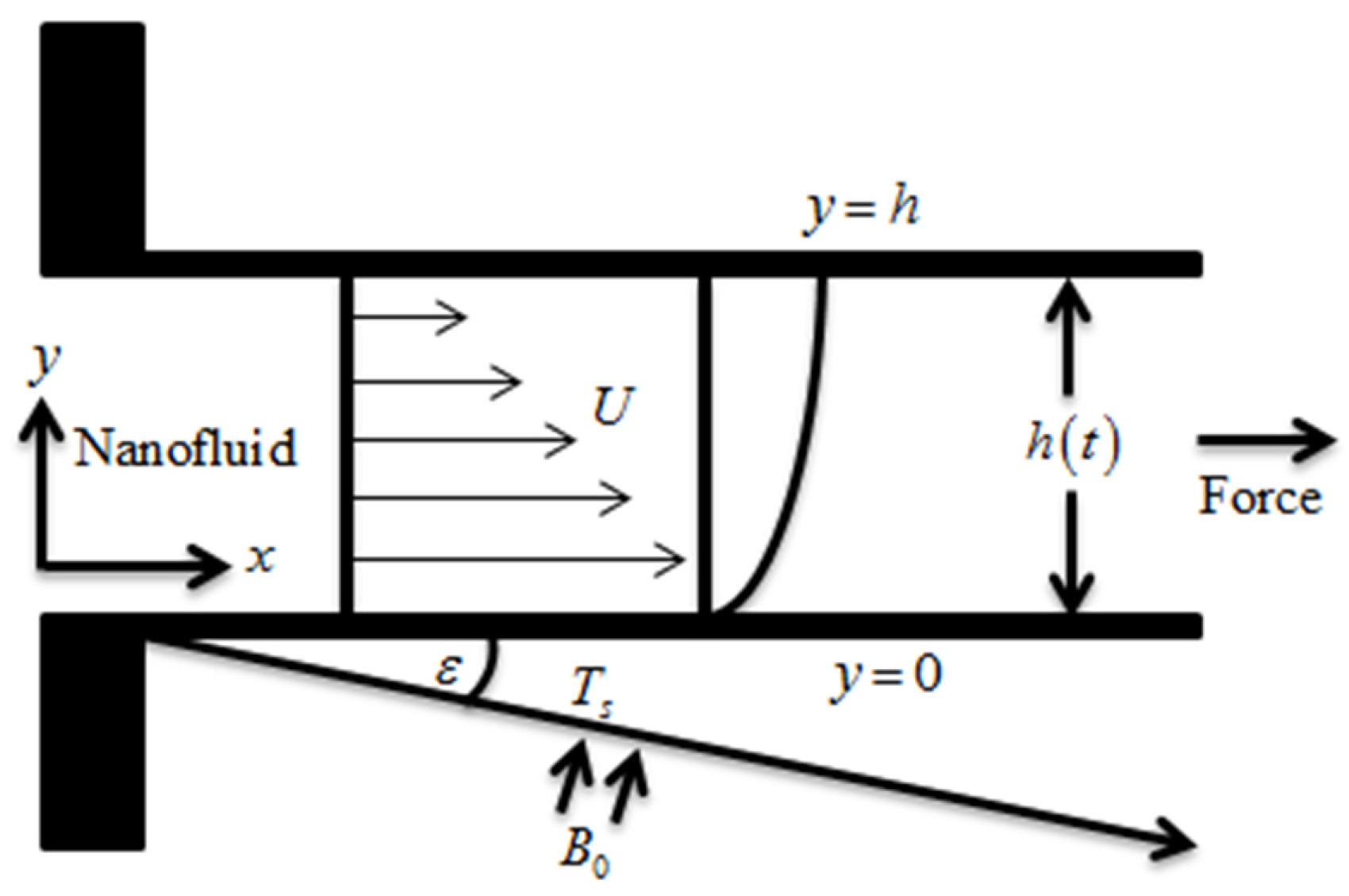
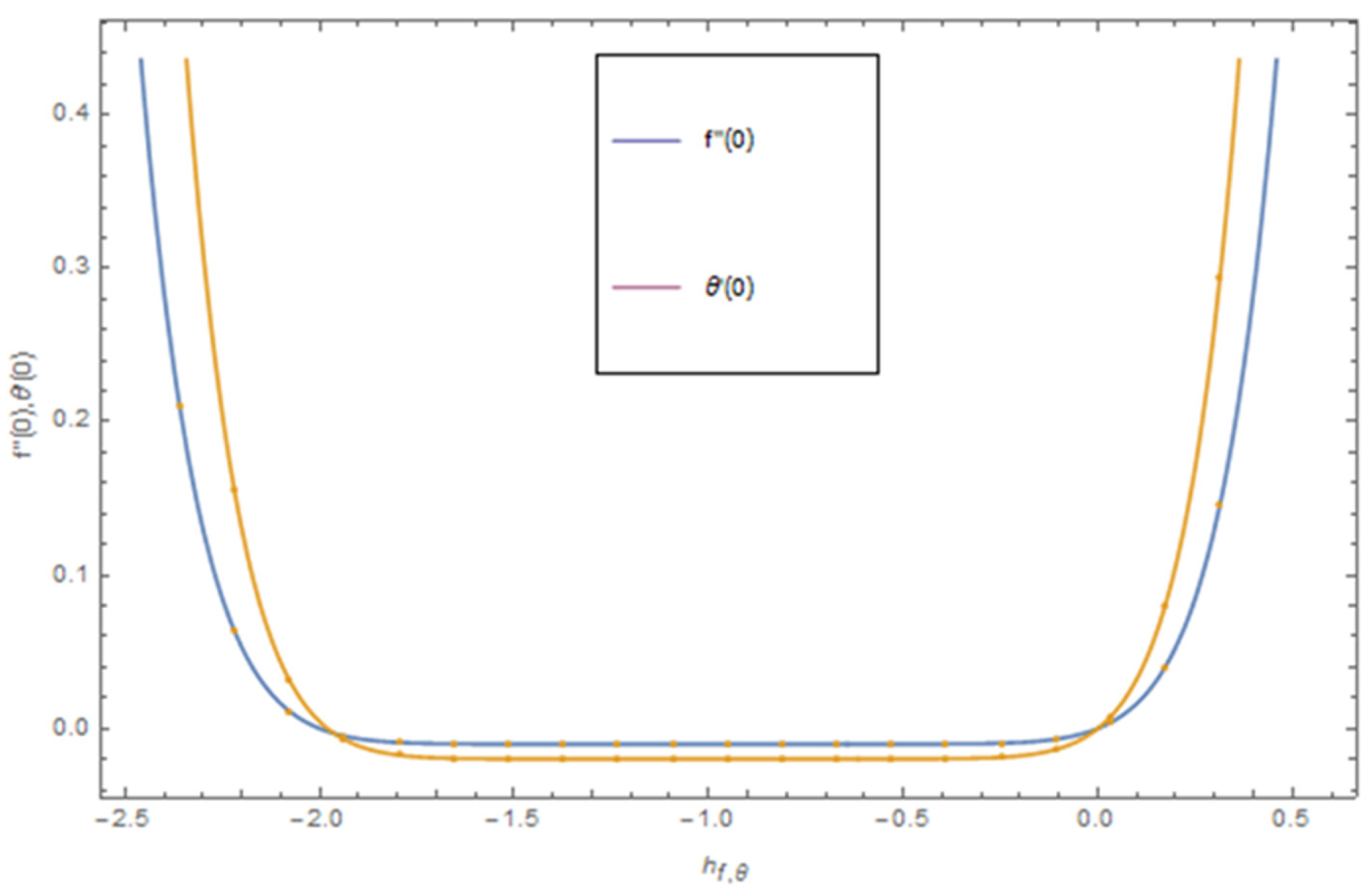

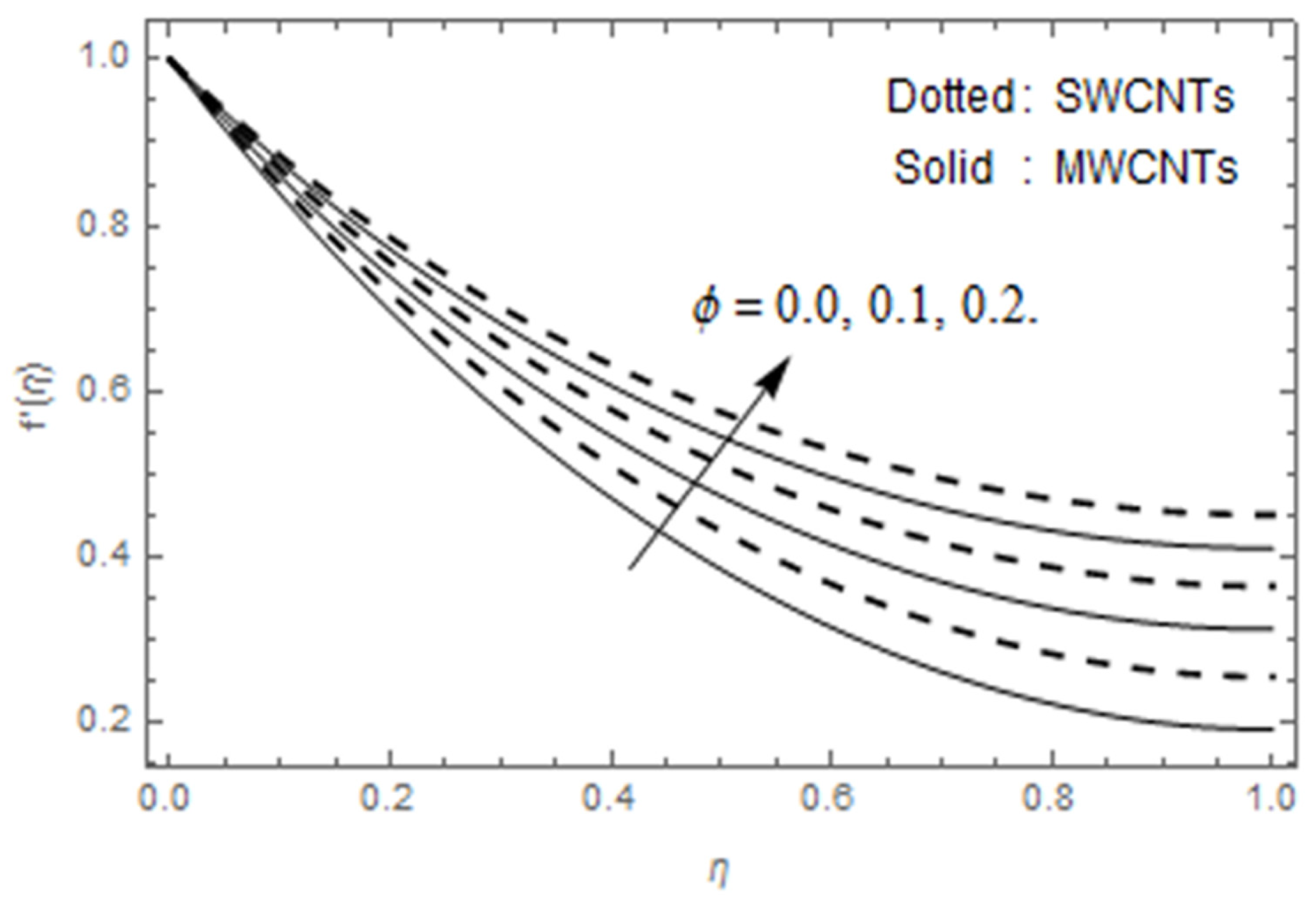
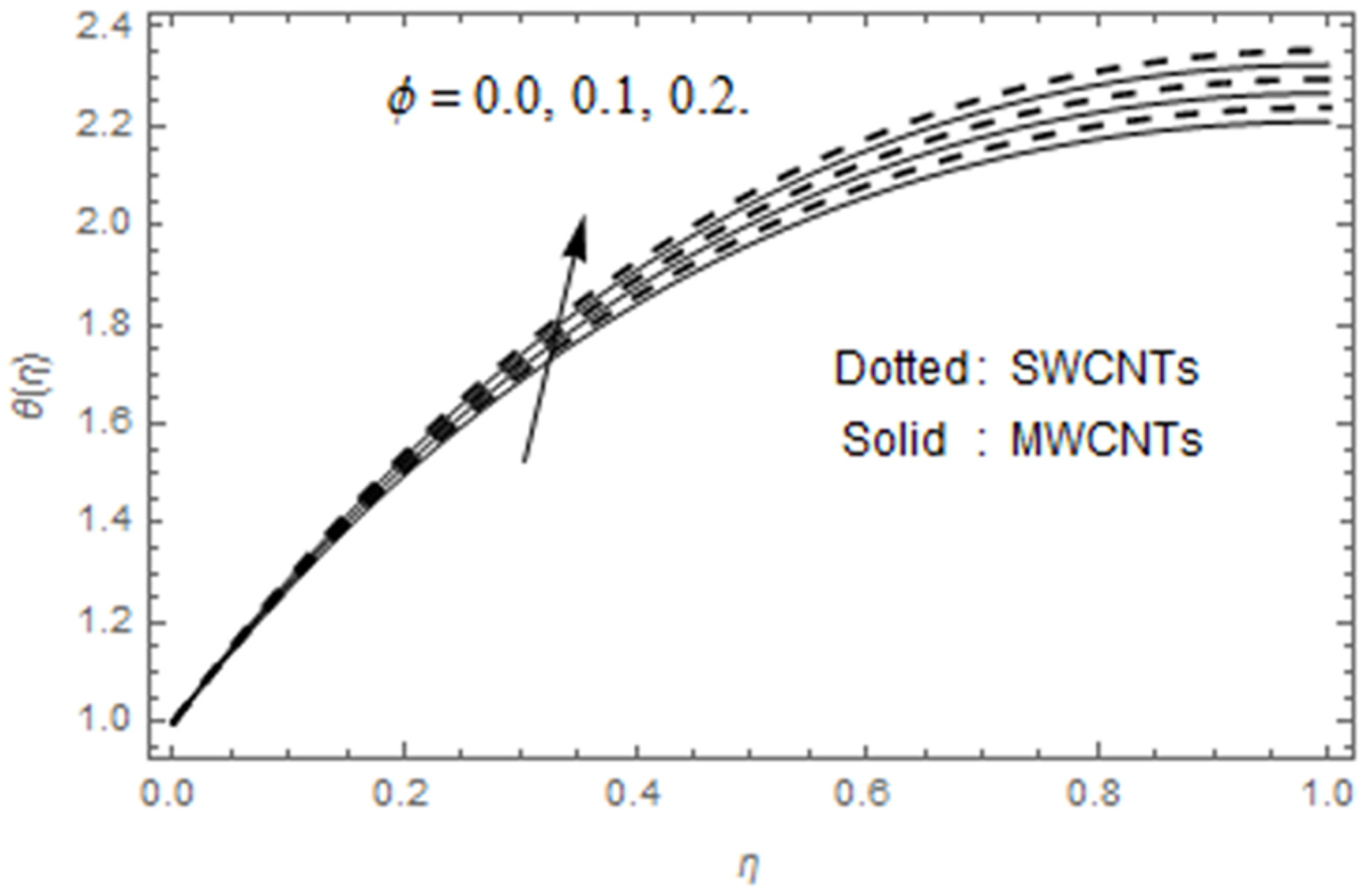
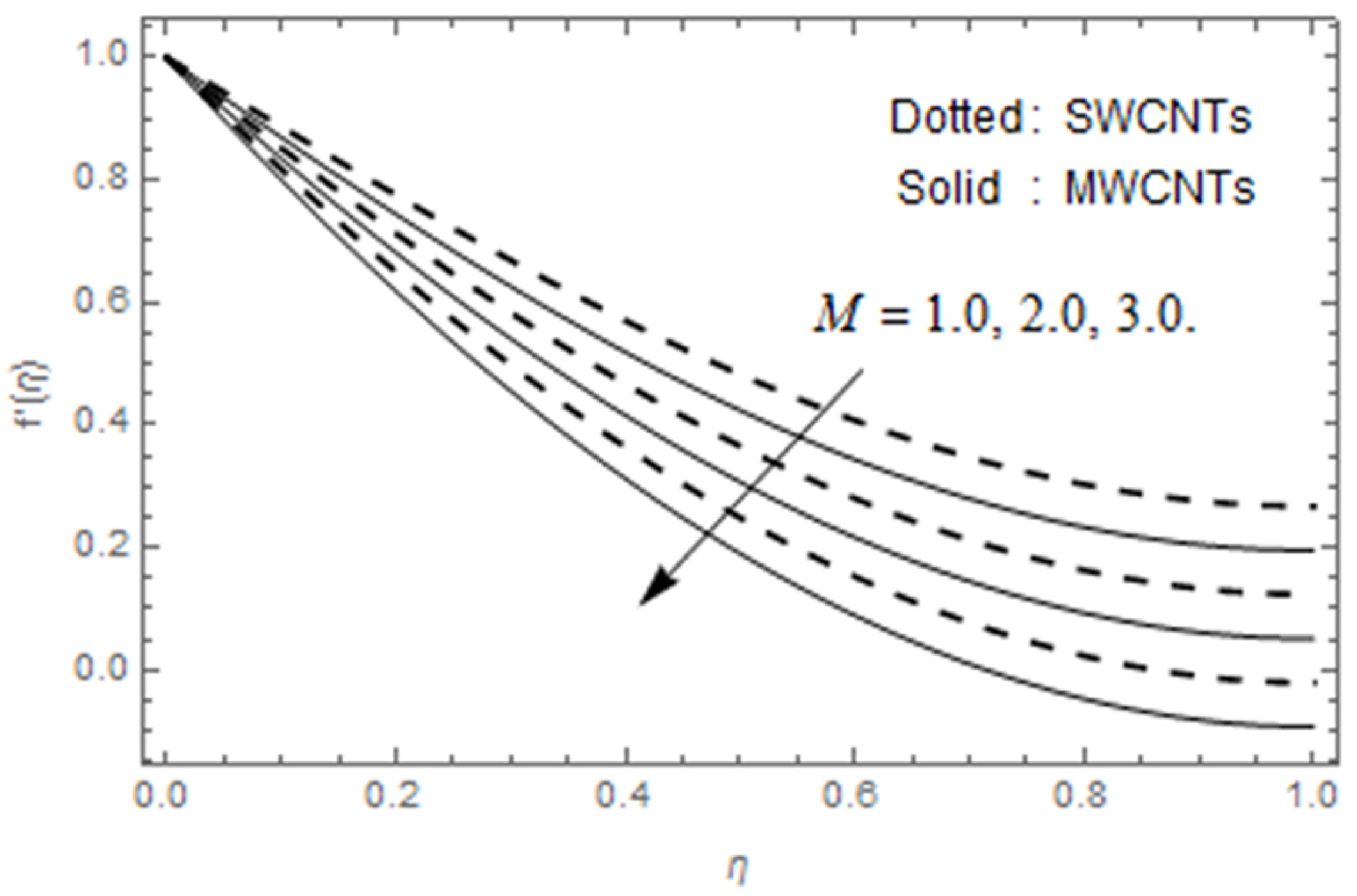
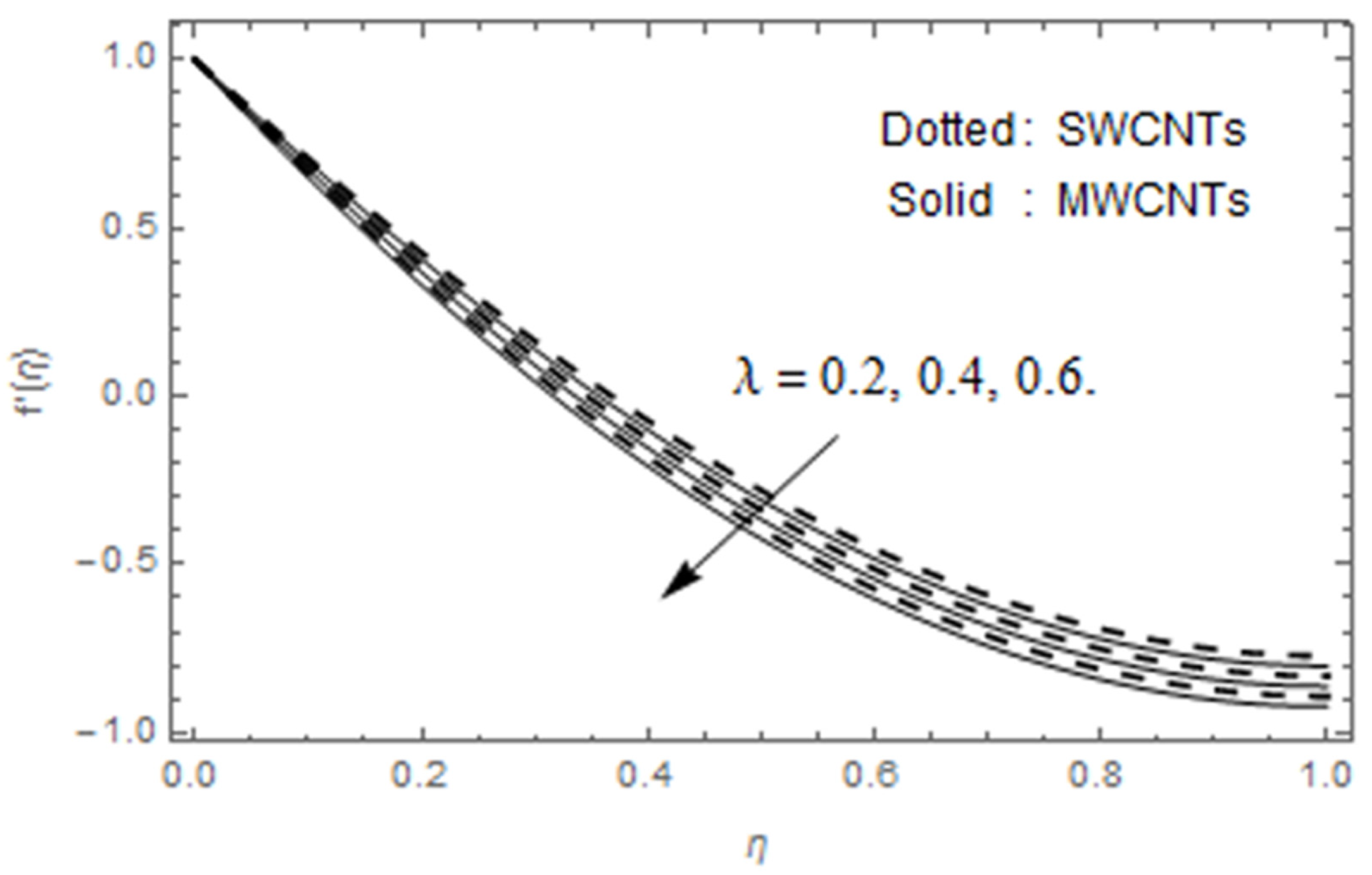

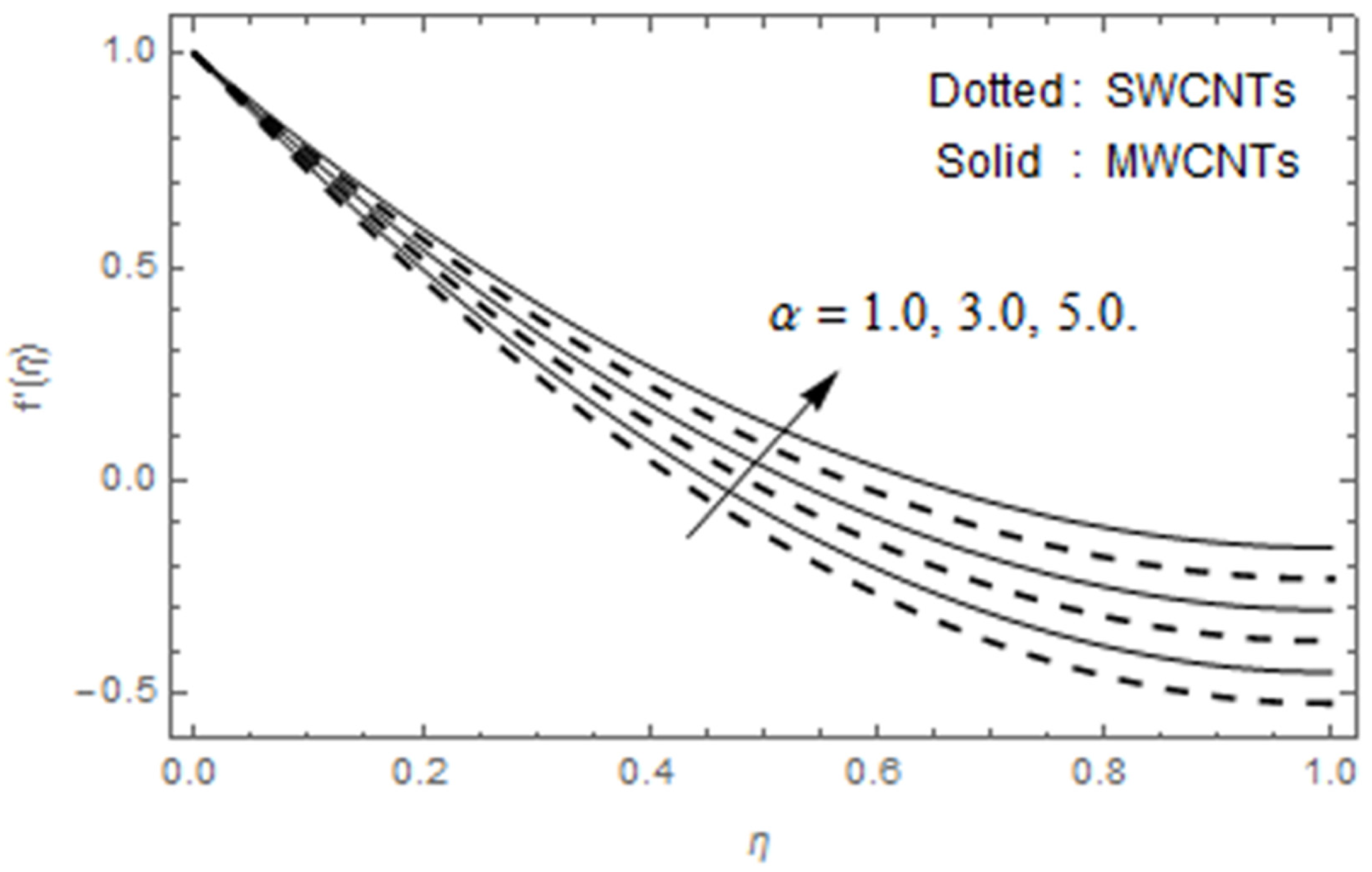
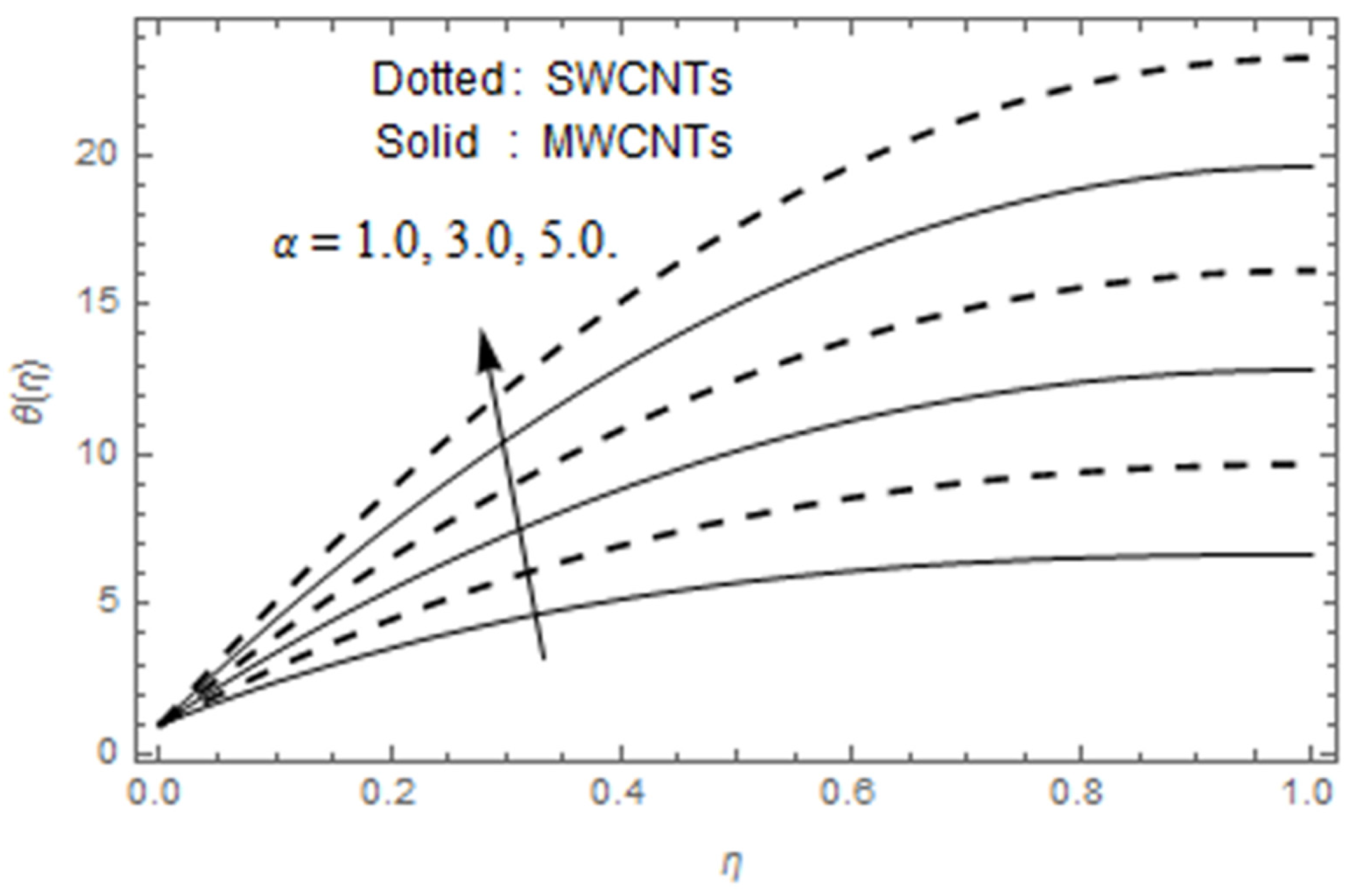
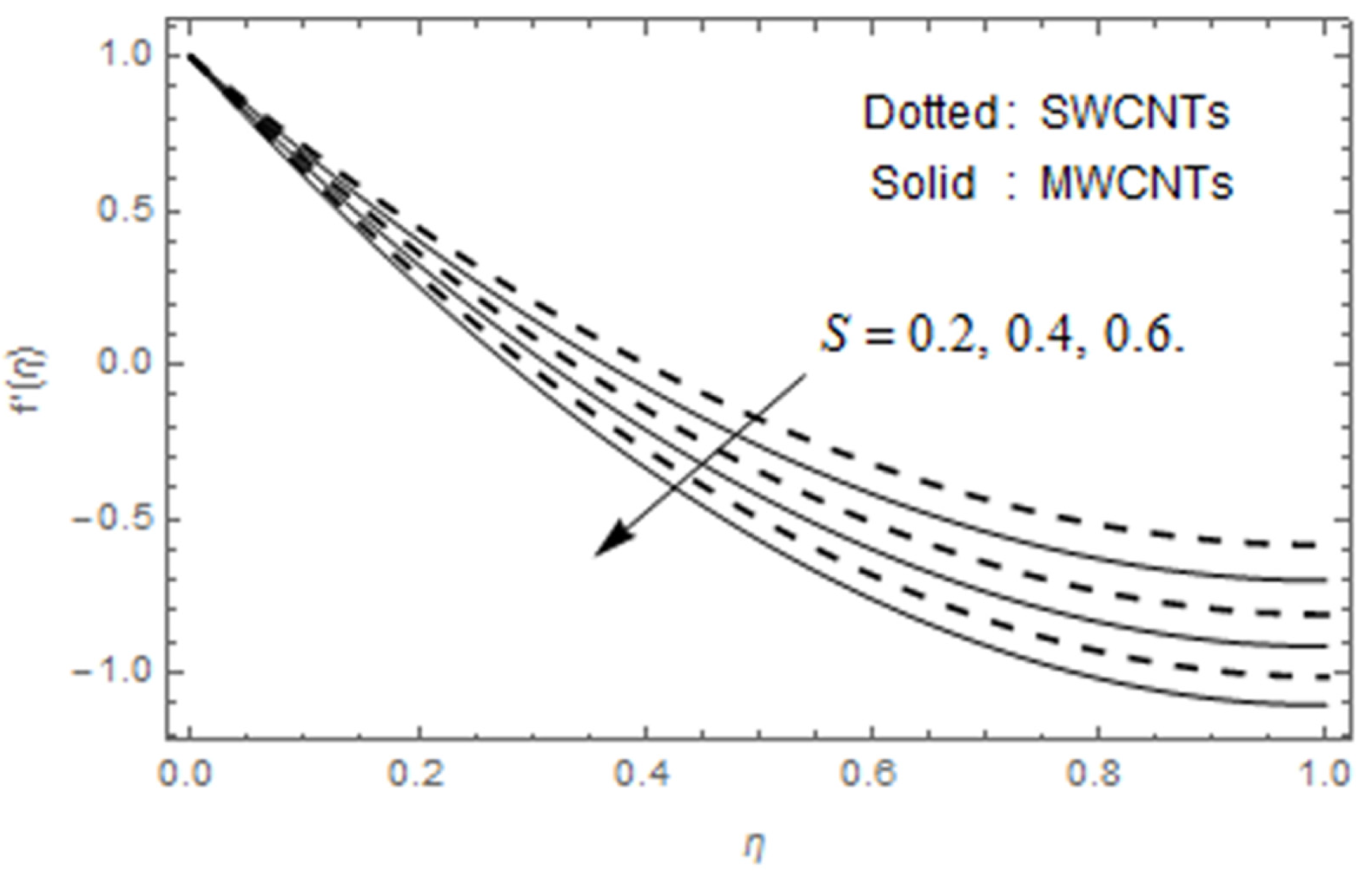
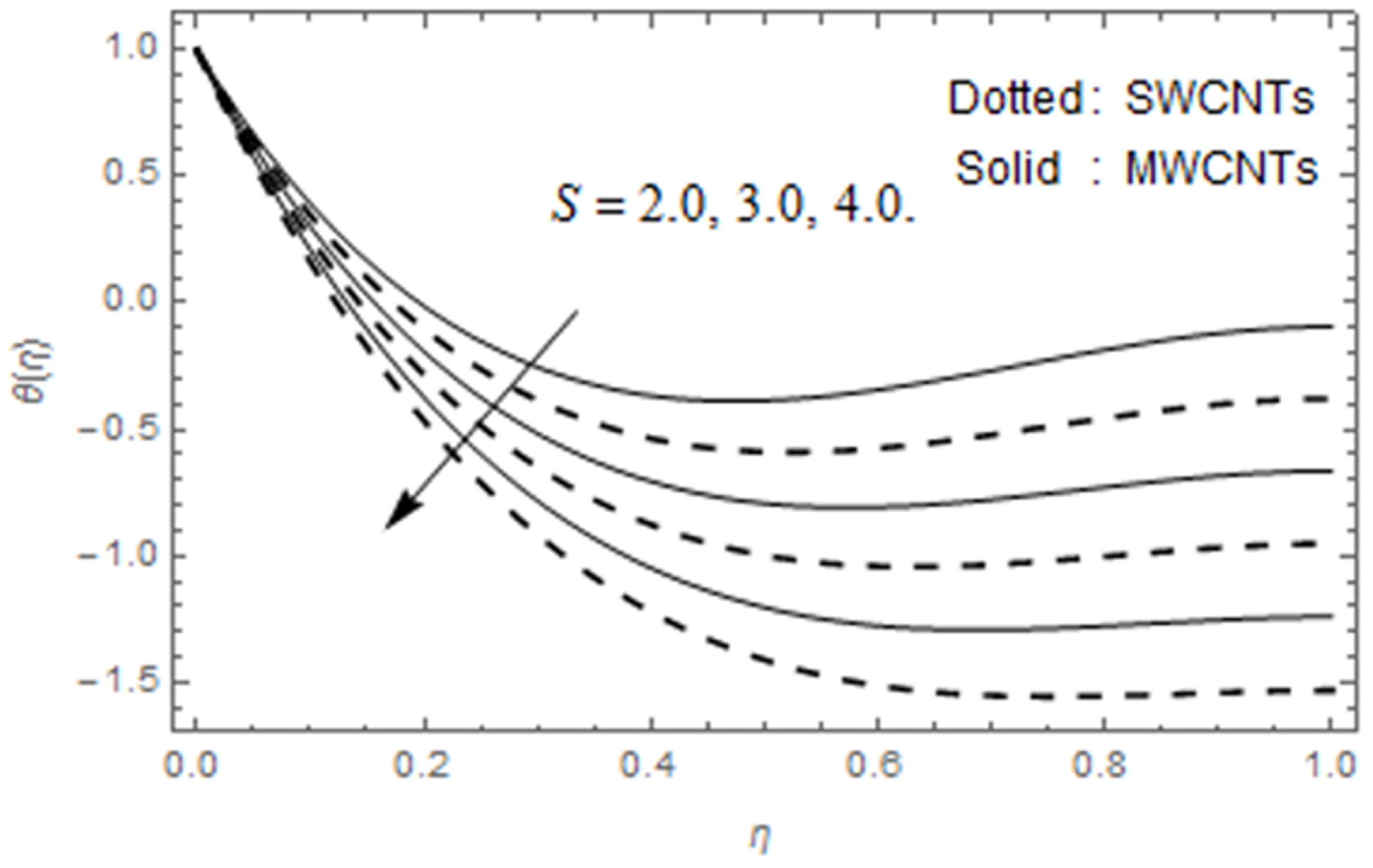
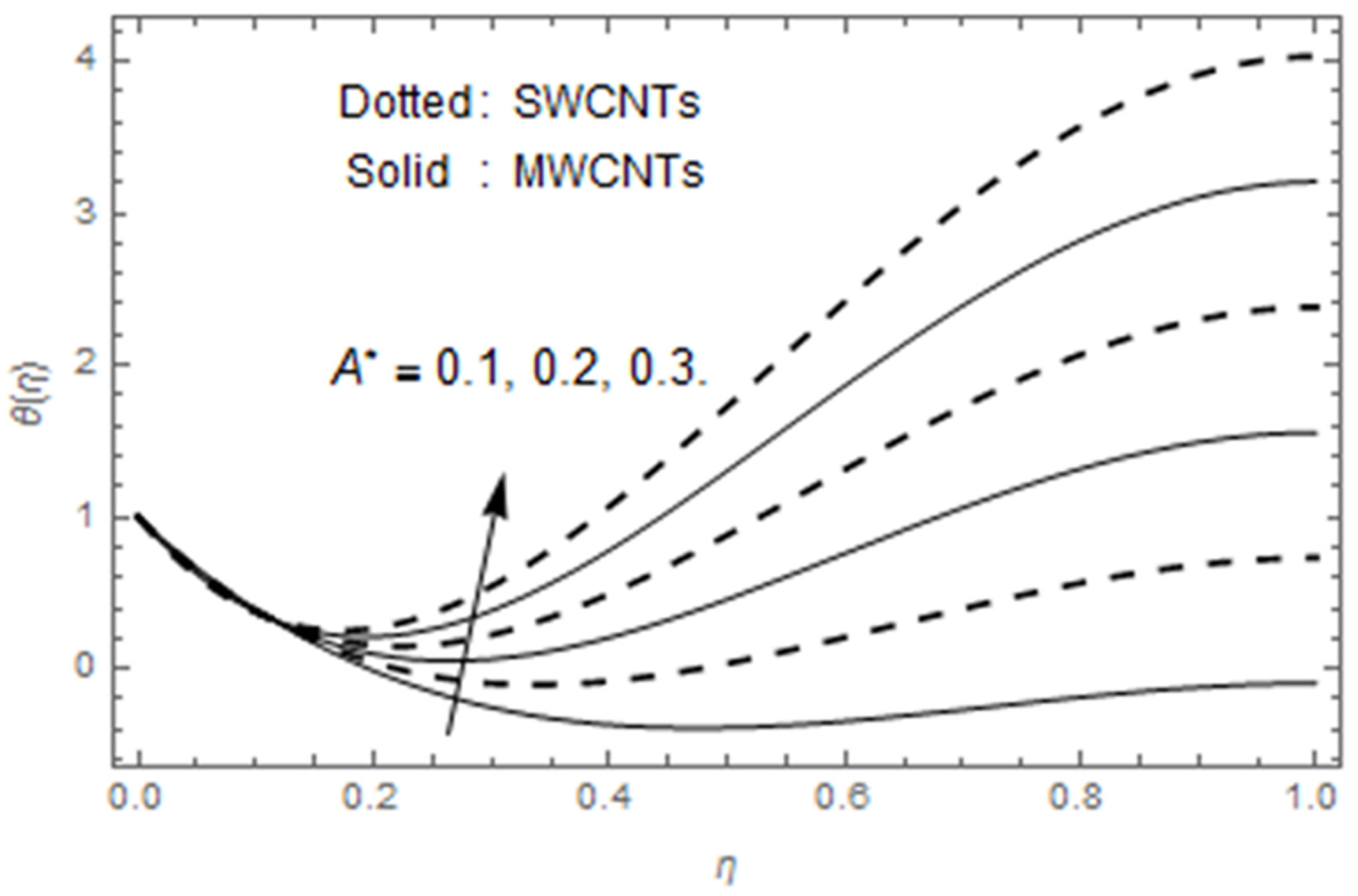
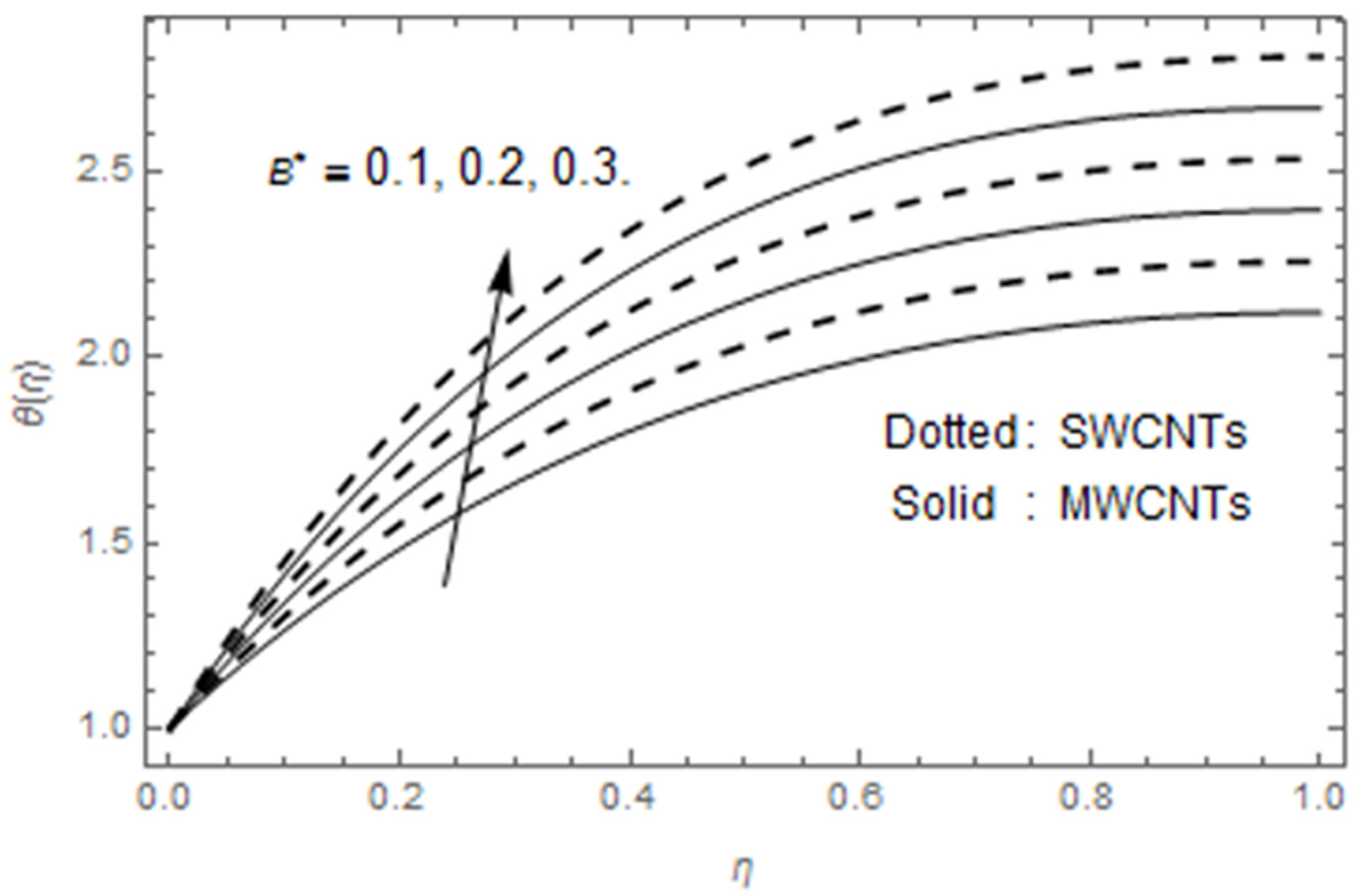
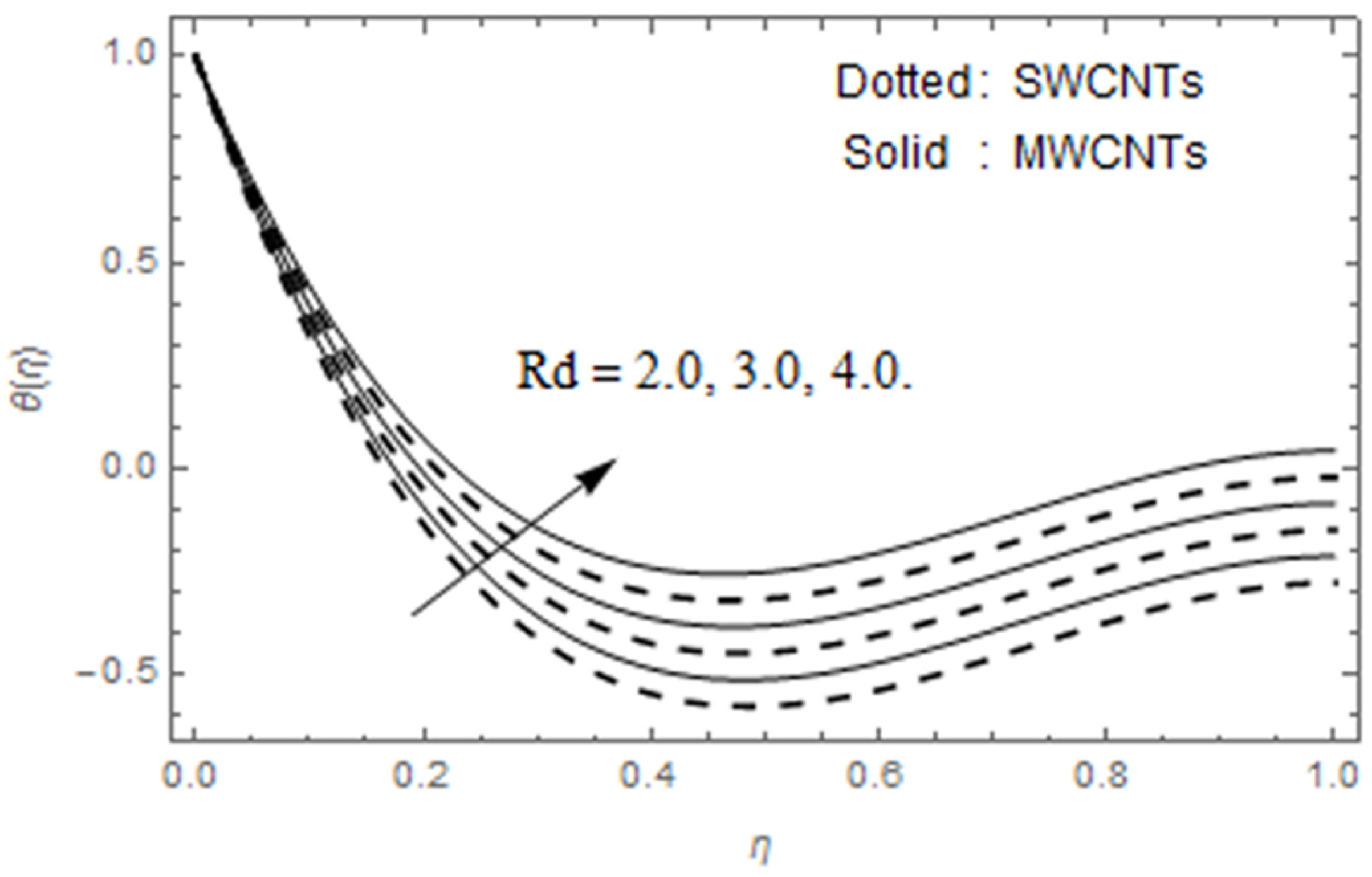
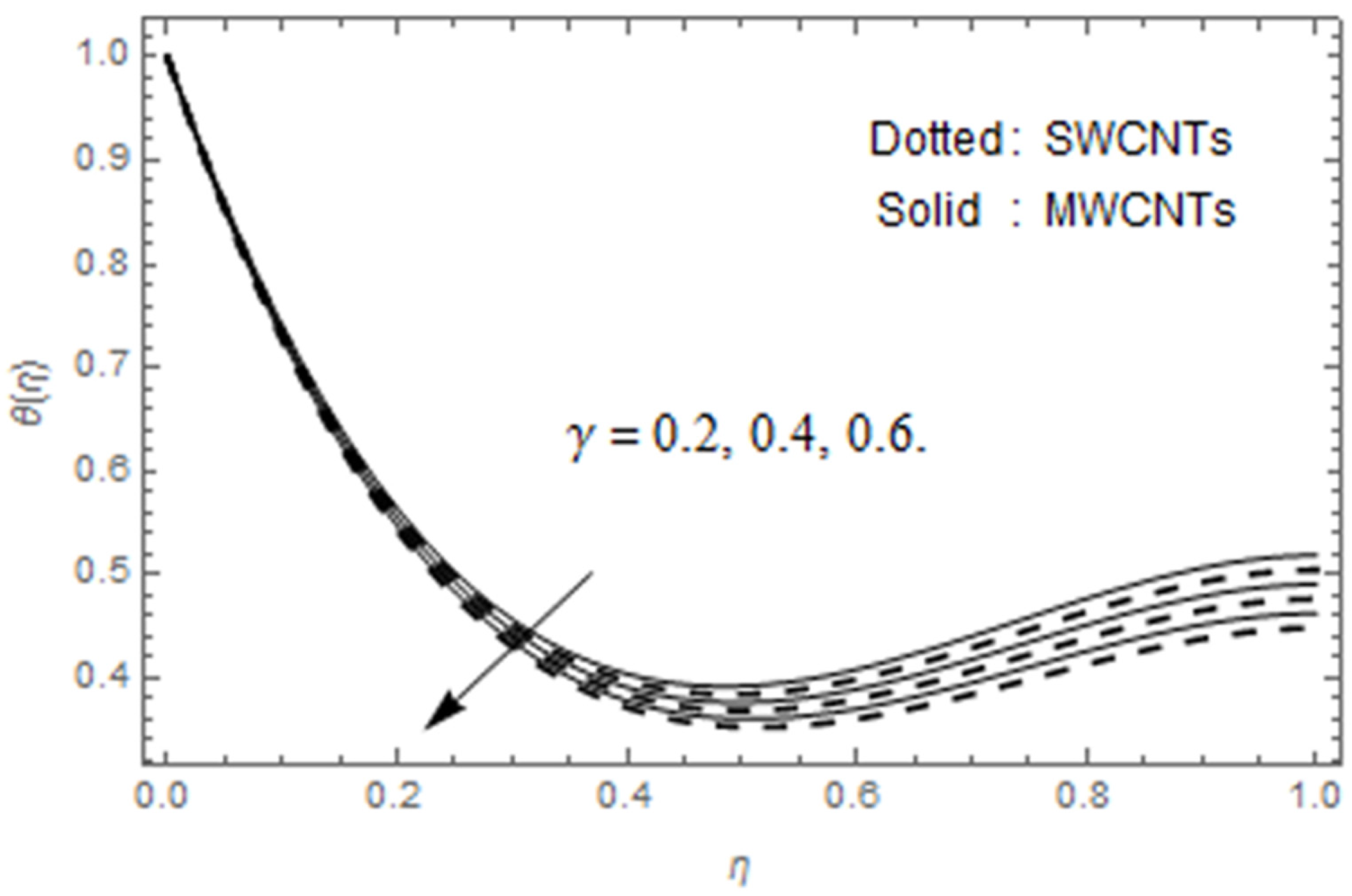
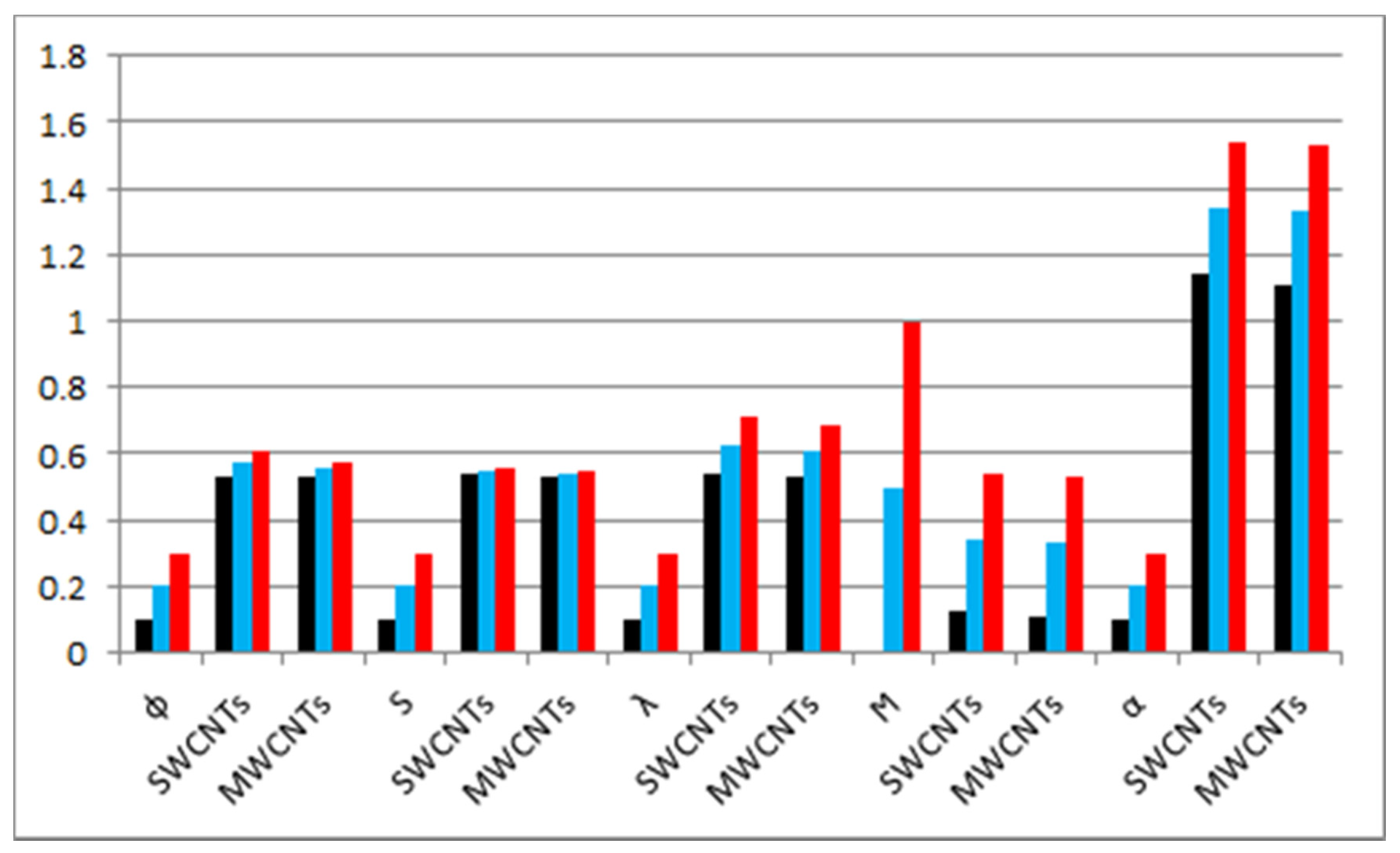
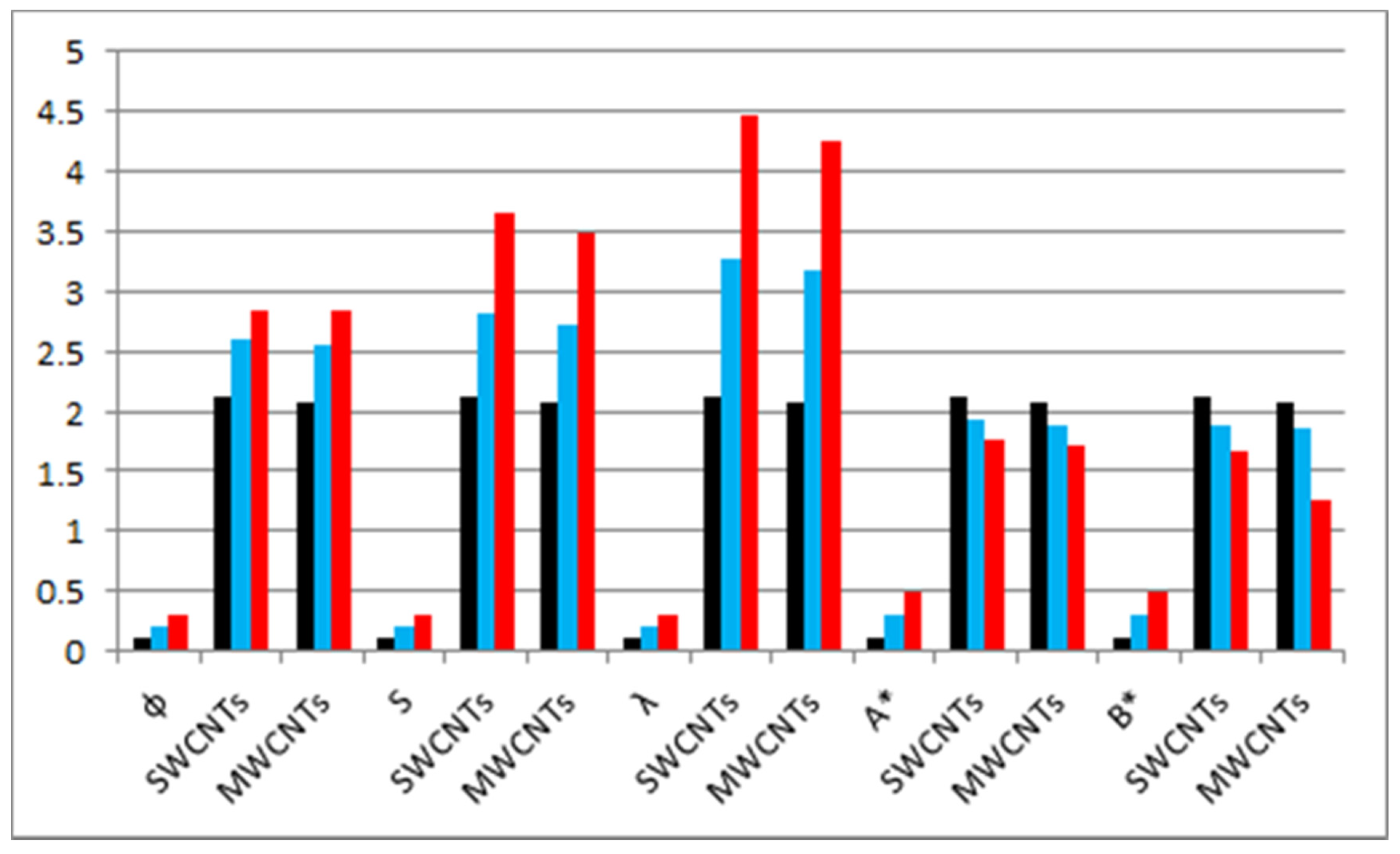
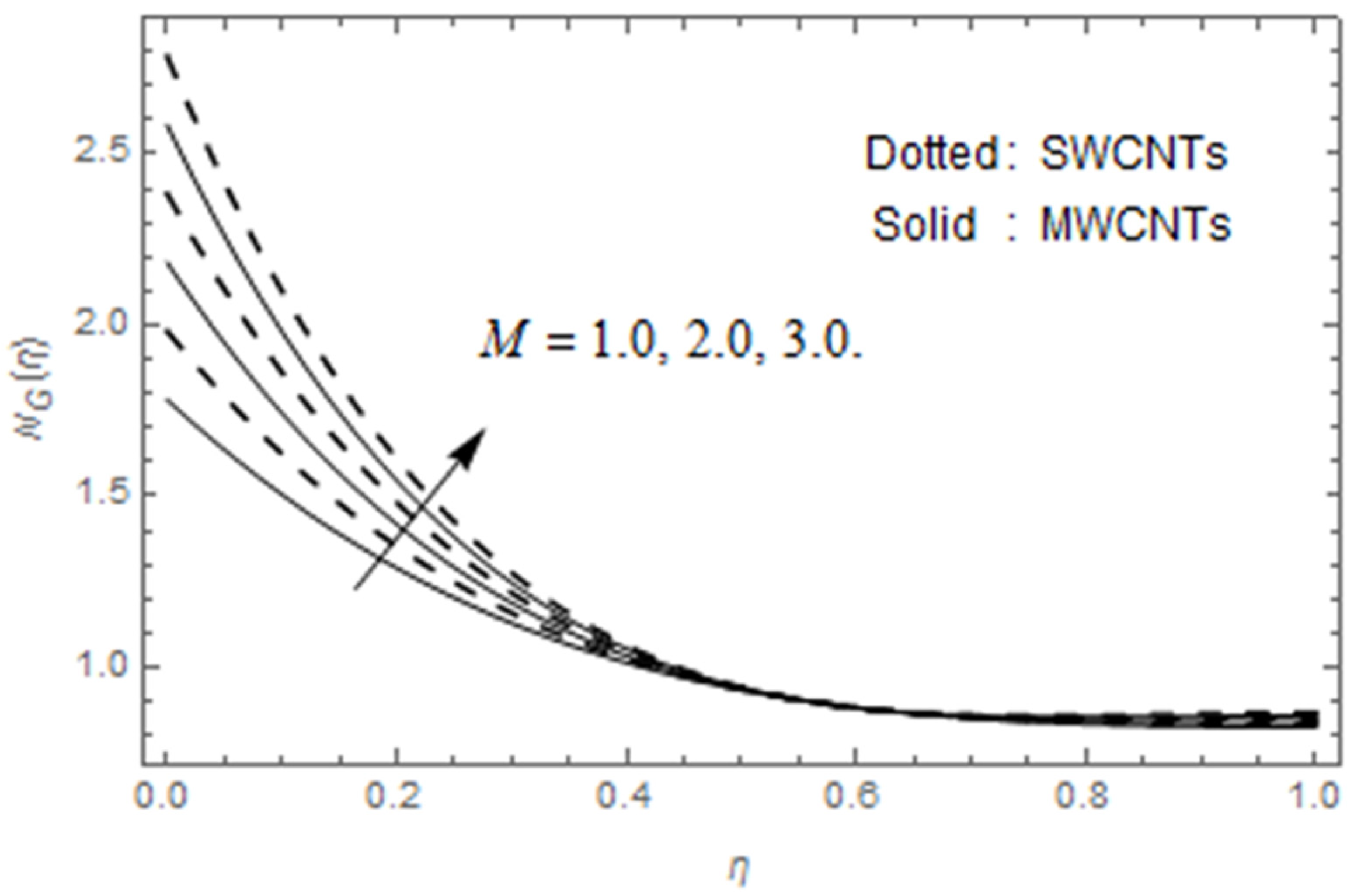
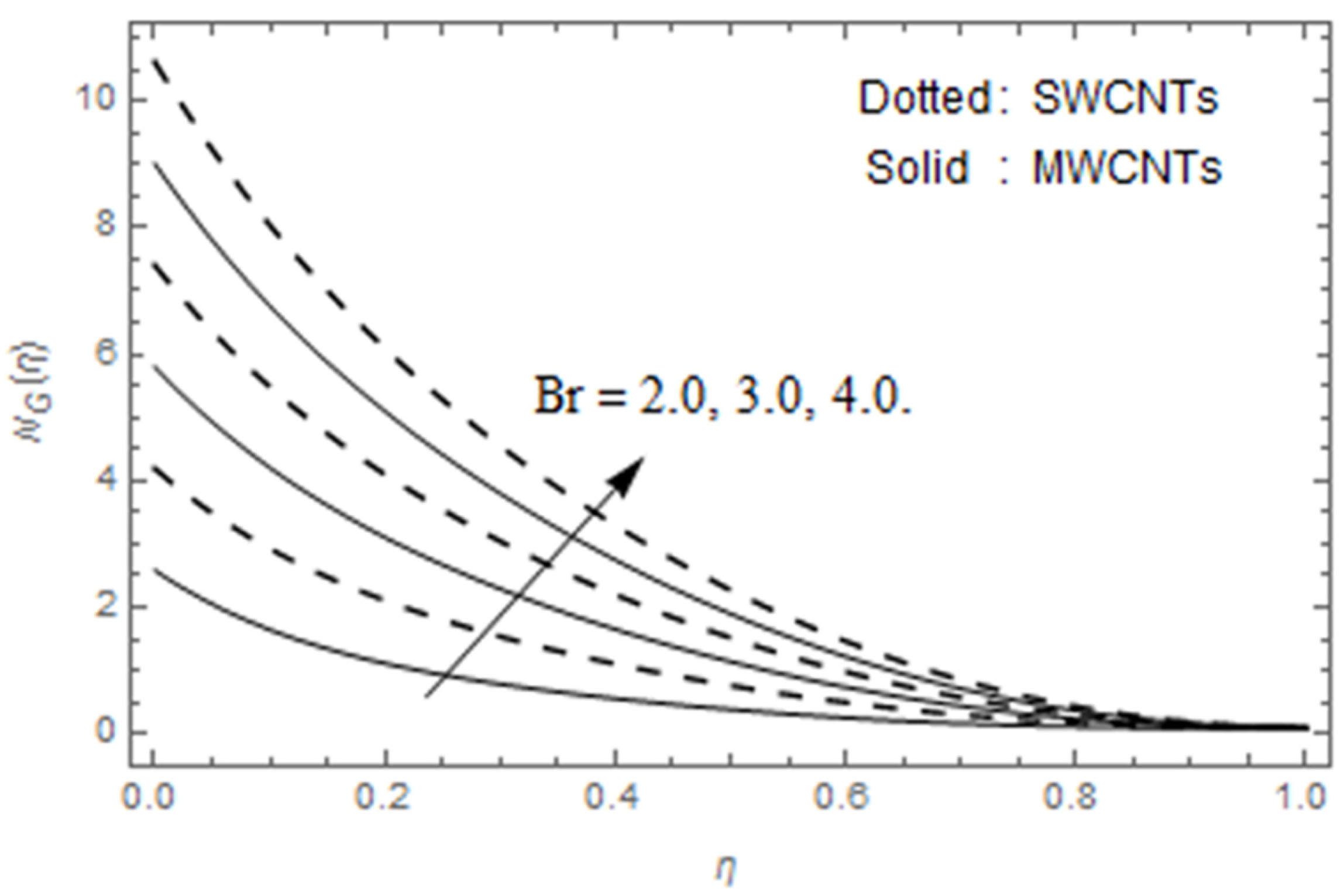
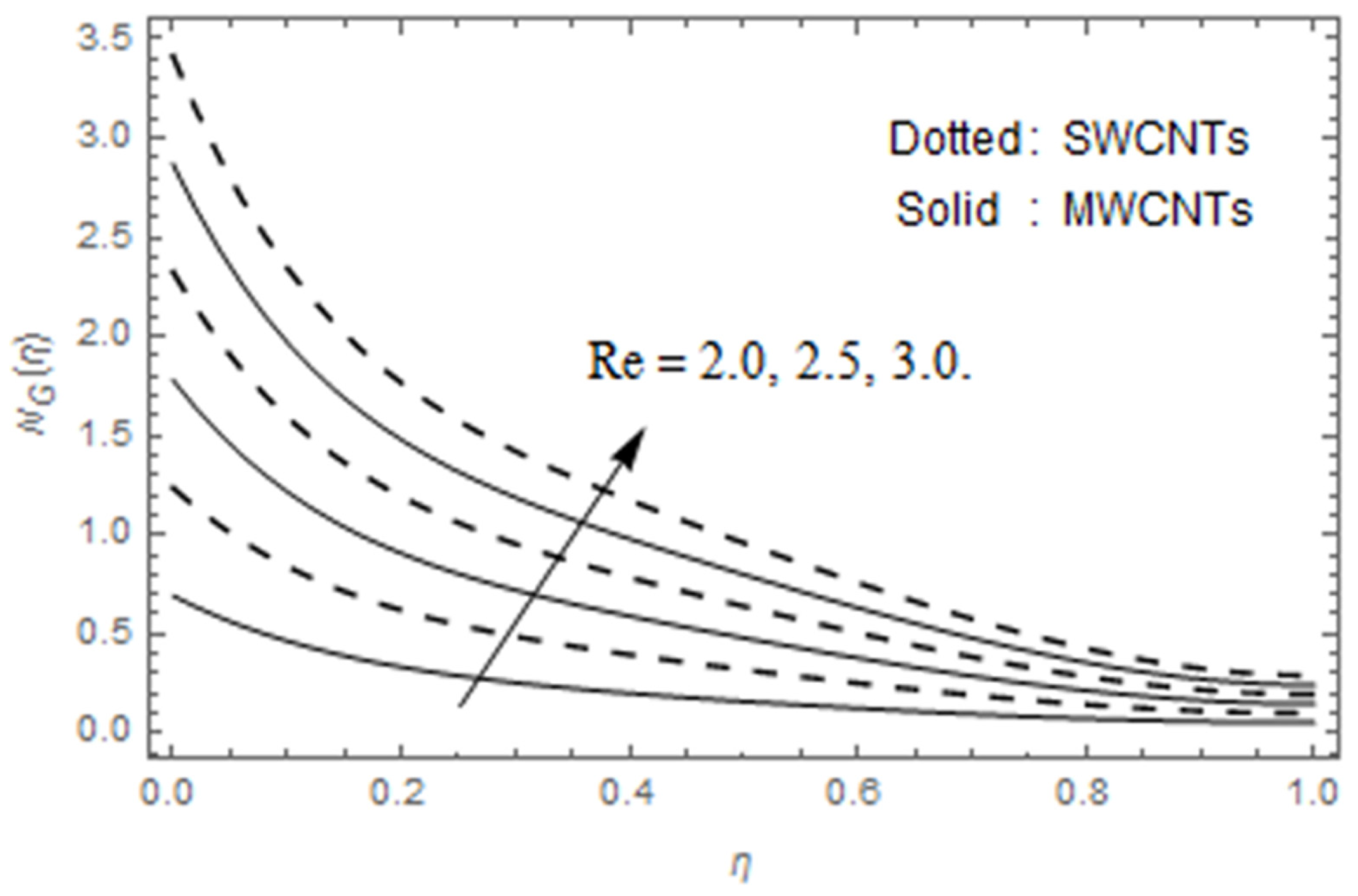
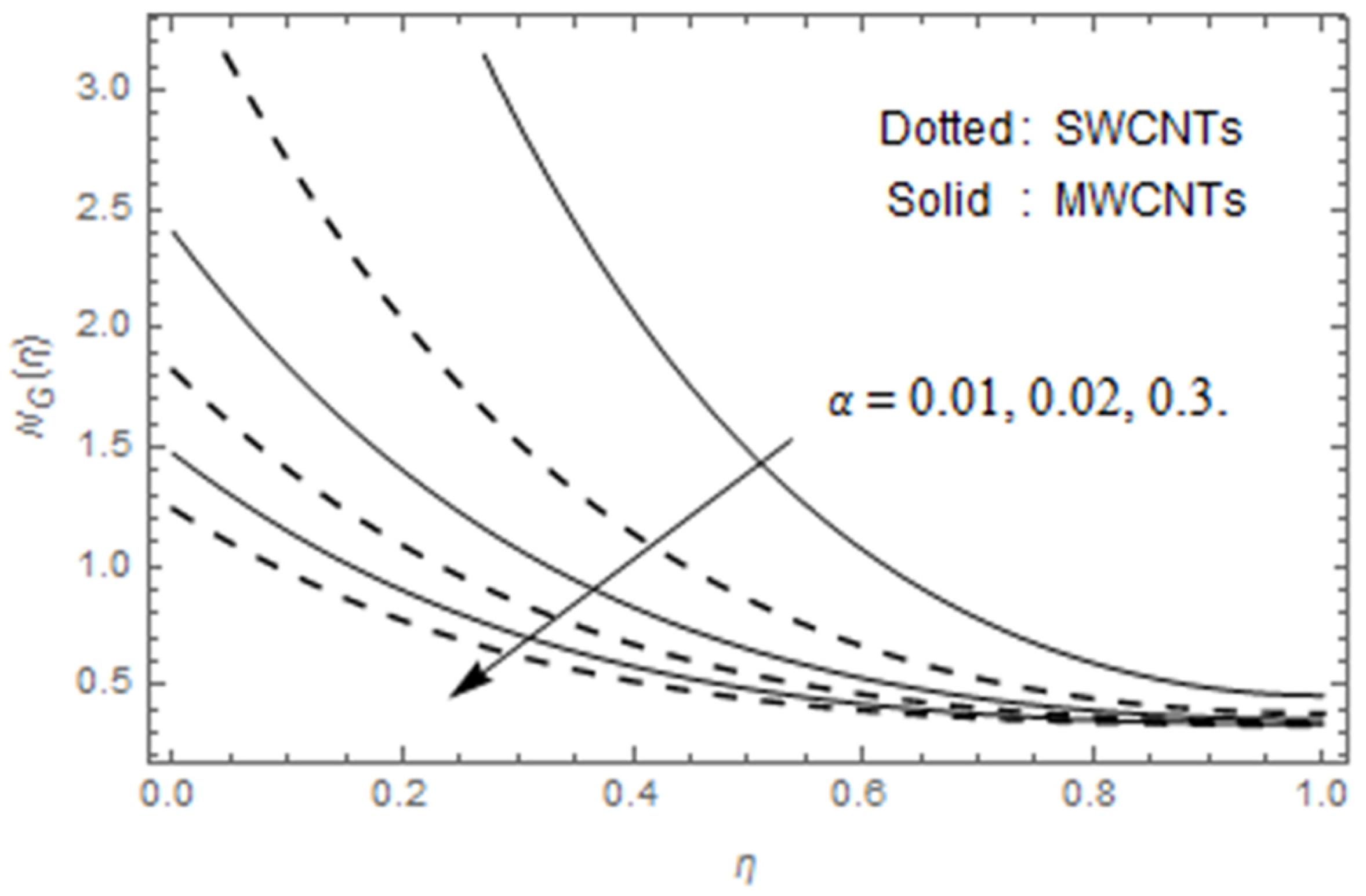
| Reference # | Second Grade Nanfluid | Film Thickness | CNTs | Heat Flux Model of Cattaneo-Christov | Entropy Generation |
|---|---|---|---|---|---|
| Ref. [17] | × | √ | × | × | × |
| Ref. [19] | × | √ | × | × | × |
| Ref. [23] | × | √ | SWCNTs | × | × |
| Ref. [24] | × | √ | × | × | × |
| Ref. [25] | × | √ | × | × | × |
| Ref. [26] | × | √ | × | × | × |
| Current analysis | √ | √ | SWCNTs/MWCNTs | √ | √ |
| 5 | 0.856220 | 0.75423 |
| 10 | 0.856222 | 0.75443 |
| 15 | 0.860002 | 0.75458 |
| 20 | 0.860001 | 0.75467 |
| 25 | 0.860001 | 0.75467 |
© 2020 by the authors. Licensee MDPI, Basel, Switzerland. This article is an open access article distributed under the terms and conditions of the Creative Commons Attribution (CC BY) license (http://creativecommons.org/licenses/by/4.0/).
Share and Cite
Shah, Z.; O. Alzahrani, E.; Dawar, A.; Alghamdi, W.; Zaka Ullah, M. Entropy Generation in MHD Second-Grade Nanofluid Thin Film Flow Containing CNTs with Cattaneo-Christov Heat Flux Model Past an Unsteady Stretching Sheet. Appl. Sci. 2020, 10, 2720. https://doi.org/10.3390/app10082720
Shah Z, O. Alzahrani E, Dawar A, Alghamdi W, Zaka Ullah M. Entropy Generation in MHD Second-Grade Nanofluid Thin Film Flow Containing CNTs with Cattaneo-Christov Heat Flux Model Past an Unsteady Stretching Sheet. Applied Sciences. 2020; 10(8):2720. https://doi.org/10.3390/app10082720
Chicago/Turabian StyleShah, Zahir, Ebraheem O. Alzahrani, Abdullah Dawar, Wajdi Alghamdi, and Malik Zaka Ullah. 2020. "Entropy Generation in MHD Second-Grade Nanofluid Thin Film Flow Containing CNTs with Cattaneo-Christov Heat Flux Model Past an Unsteady Stretching Sheet" Applied Sciences 10, no. 8: 2720. https://doi.org/10.3390/app10082720
APA StyleShah, Z., O. Alzahrani, E., Dawar, A., Alghamdi, W., & Zaka Ullah, M. (2020). Entropy Generation in MHD Second-Grade Nanofluid Thin Film Flow Containing CNTs with Cattaneo-Christov Heat Flux Model Past an Unsteady Stretching Sheet. Applied Sciences, 10(8), 2720. https://doi.org/10.3390/app10082720






